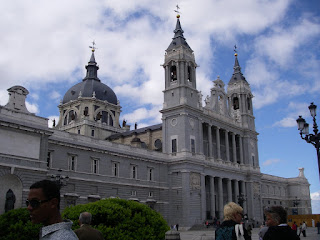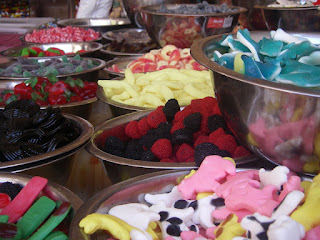This morning, I was awoken suddenly by the shrill oscillating tones of the telephone. I rolled slowly over to my other side to continue sleeping in a lazy state that would soon change, as I glanced at the clock that to my horror said 9:30 a.m. Like a jack-in-the-box I jumped out of my bed and began to throw on my clothes and find my belongings; at 9:30 all students were to be at the
acueducto, a fifteen minute walk from my house, and ready to leave for our trip to Toledo. On my nightstand sat my alarm clock, set with the perfect time, but with a knob placed oh so inconveniently by the word "off." I could hear the voice of Jesús downstairs talking to our guide Ricardo, and before he could tell me to do so I threw my unwashed hair up in a bun and flew down the stairs so he could drive me to where the other tired students sat waiting. I will forever be grateful that the bus waited just fifteen more minutes for me to arrive, because the city of Toledo is the visit of a lifetime.

Capital of the Autonomous Community of Castilla-La Mancha and the province of Toledo, Toledo is known as the "city of three cultures," a reference to the Christian, Muslim, and Jewish cultures that coexisted there through various centuries and that give the city its unmistakable character. There, the assimilation of cultures is evident right before your eyes, in the architecture, even in the souvenir shops. Like a giant blender Toledo has mixed together the three major religions of the world to make something new, hybrid products that cannot be seen anywhere else in the world. All its beauty lies in the intersections of cultural lines that zig-zag and cross each others' paths in a web of integration.
Our first stop on our tour was La Catedral. What began its construction in 1226, combines Gothic elements with other styles in a way that can take your breath away. As we lined up outside to take pictures, our guide, Gloria, could only laugh. "The outside is nothing," she said, "compared to the beauty inside." If a picture is worth a thousand words, and because photography was again prohibited, I could not type in my lifetime what the church, tall with arcs decorated with marble statues that burst out of the wall, painted angels that flew over the ceiling, and intricate works of wood and gold that adorned every element inside, looked like.

The altar, which faces East where the Sun rises in order that the people walk toward the light of God, had not always been the centerpiece of this church. In fact, this building had not always been a church either; it was a mosque. The centerpiece of the mosque is the
mihrab, or a small highly decorated niche in a mosque that always faces Mecca (in Toledo's case Southeast), so that believers will know inside which direction to pray. After the Reconquista, the Catholic "reconquest" of Spain, the rebuilding of this cathedral over the original mosque required an entire reorientation of the building.
Another example of the Christian influence left in the path of the "reconquerers" is La Sinagoga del Tránsito. Unlike any synagogue in the United States, this building had on its far wall images of baby angels and even a cross. Just as well, the Muslim influence was undeniable. Facades were adorned with beautiful works of plaster in the
mudéjar style characteristic of Muslim architecture. The arches too were not curved in one smooth line, but rather shaped like a keyhole, a foundation of Muslim architectural style. Sam, the only Jewish student on the trip, said he hardly felt like he was in a synagogue at all.
The melting pot of religion has survived through time in art as well, a phenomena we could see even in the gift shops. The art of Damascene, interlacing gold on iron or steel to produce beautiful decorative designs has become a trademark of Toledo.

Practiced for centuries in Egypt, the origin of the word is thought to come from Damascus, now the capital of Syria, that was once capital of the Muslim Empire. But in every shop we went, this Arabic art form was used to decorate both crosses and the Star of David. Windows shimmered with a Damascene splendor that reflected parts of three cultures at once. But still, it is hard to explain the magnificence of Toledo. I could write forever on what these three cultures brought to the city, yet something would be missing, an element so distinct I had only seen it in this city. Because as we all know, just in the taste of Mom's homemade mashed potatoes, that the whole, is more than just the sum of its parts.



















































